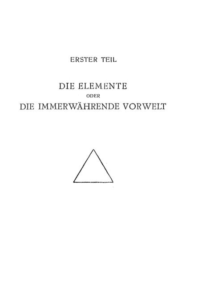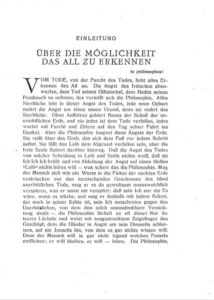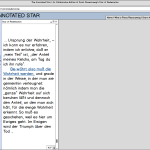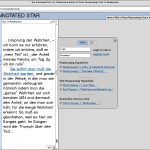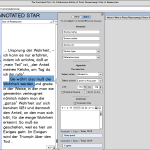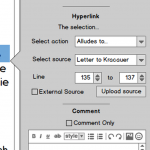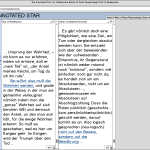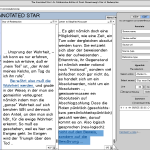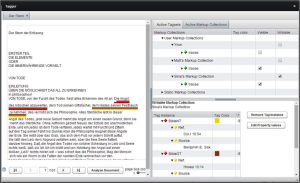Explore a prototype of our annotation tool
Rosenzweig’s The Star of Redemption occupies a significance place in German, Jewish, and German-Jewish cultural and intellectual history. It marks, as Amos Funkenstein has claimed in Perceptions of Jewish History, the end of German-Jewish history. As Gershom Scholem wrote in 1961 to Martin Buber on the occasion of the completion of his translation of the Bible from the Hebrew into modern German, which Buber had begun in 1924 with Rosenzweig:
“Now whether you consciously so intended it or not, your translation […] was a kind of parting gift [Gastgeschenk] which German Jewry gave to the German people, a symbolic act of gratitude upon departure.”
Yet, “seen historically”, adds Scholem, “it is no longer a Gastgeschenk of the Jews to the Germans but rather – and this is not easy for me to say this – the tombstone of a relationship that was extinguished in unspeakable horror.” To a certain extent, the same could be said about the entire life and work of Franz Rosenzweig, perhaps the last German-Jewish philosopher whose work was self-understood as belonging both to a German and a Jewish tradition.
Rosenzweig began his major published text, The Star of Redemption, during the First World War War and completed and published it in 1921. Seeking to supplant the philosophical tradition of German idealism, Rosenzweig still draws on the writings of Hermann Cohen, Immanuel Kant, FWJ Schelling, GWF Hegel and many others to give a philosophically rigorous justification for Judaism’s relevance as a modern form of belief. The text finds the revelation of divine love in language, arguing that Christianity and Judaism both participate in the work of redemption, in which the enduring presence and belief of the Jews anticipates the eternal kingdom. The Star of Redemption’s significance in German-Jewish religious and philosophical discourse was immediately realized by its contemporaries and their followers, such as Scholem and Emmanuel Levinas. The book now inhabits a precarious space between the disciplines of philosophy, Jewish Studies, Religious Studies as well as German Studies – due, in large part, to the ideas, concepts, and quotes Rosenzweig borrows from Judaism, Christianity, philosophy, German literature, history, linguistics, mathematics, chemistry and many more subjects. Nonetheless, this curious and perhaps final landmark of the tradition of German-Jewish philosophy continues to attract readers and critical attention both for its historical significance as well as its complex paths of reasoning, its nuanced web of philosophical, religious, and literary allusions, and its aesthetic mastery of the German language.
CREATING A SPACE FOR SCHOLARS TO SHARE THEIR WORK
The expansive network of references in The Star of Redemption has continually pushed traditional, single scholar research to its limits. We thus conceive of the Annotated Star as an online collective resource and, eventually, a platform and community of interpreters and editors, who share the task of uncovering intertextual references in The Star of Redemption. Indeed, as The Star of Redemption advocates for collective religious community, revealing its hidden literary treasures should likewise be collaborative and communal effort aimed at exploring The Star of Redemption’s cultural depth and historical and linguistic resonances. It is a book that not only enables, but rather invites commentary, discussion, exploration and further learning.
And yet, The Star of Redemption expansive network of reference also puts up barriers to its own interpretation. Many of the allusions to and quotes from the Bible and the Talmud, from Goethe and Schiller are not signed with the quotation marks and numbered references contemporary readers may expect. To some of Rosenzweig’s contemporaries, these allusions may have been more transparent, and still, they required a hybrid education in German philosophy and literature as well as thorough acquaintance with Jewish sources. (Indeed, realizing the book’s opaqueness, Rosenzweig asked for the assistance of Nahum Glatzer in compiling an index of Jewish sources which was added to the second edition of The Star of Redemption, published in 1930.) In order to enter the philosophical-religious discourse of Rosenzweig and his contemporaries today, one needs a similar community of interpreters and editors – a community that take as its task the uncovering, connecting, and sharing of intertextual references across Rosenzweig’s life and work. The goal of the the Annotated Star is to realize this community of interpreters through modes of scholarship enabled by digital technologies.
We envision the Annotated Star to be a digital platform that will allow users to annotate The Star of Redemption, linking passages to their possible references and allowing readers to explore the intertextuality of Rosenzweig’s work. We thus envision something that would be cross between scholarly social media and a digital version of the Talmud, in which readers mark references and sources in The Star of Redemption and share their commentary on the text with other scholars. Users will be required to register and site administrators will verify and approve new user accounts and edits to comments and annotations. All visitors will have the ability to access texts and annotations stored on the site (Fig. 1) and to login or register (Fig. 2). Registered users can add annotations, comment on previous annotations, and upload and link new texts to an original selection (Fig. 3 and Fig. 4); open hyperlinked, parallel documents (Fig. 5), and continue the process with the newly linked text (Fig. 6).
To facilitate side-by-side intertextual comparison, as in Fig. 5 and 6, the initial version of the Annotated Star will include works preloaded into the site’s text database, such as Rosenzweig’s letters to Margarete Rosenstock-Huessy, versions of the Old and New Testament in the public domain, and a representative selection of out-of-copyright works from the German cultural tradition. Check out a working prototype of our annotation tool. Use the left pane to navigate through The Star of Redemption. Tagged references are indicated by a color underline beneath the text. Clicking on the text will open the reference text in the right pane. For instance, the second line of Rosenzweig’s text (“Die Angst des Irdischen abzuwerfen”) is a well-known reference to Friedrich Schiller’s poem “Das Ideal und das Leben” (1795, “Werft die Angst des Irdischen von euch”). Please note that this is version is only a prototype.
The Annotated Star’s primary audience includes scholars of German-Jewish culture and history, philosophers, and Rosenzweig specialists, such as the hundred-plus members of the International Rosenzweig Society. When released for public use after further development, the Annotated Star will benefit a wide audience of humanistic scholar working primarily on texts and interested in questions of intertextuality and cross-textual analysis.
At least two types of references in The Star of Redemption invite extensive collaborative commentary. Rosenzweig’s articles, letters, journal entries, and other texts provide a wealth of material upon which he draws in The Star of Redemption. In them, he also discusses and documents the book’s successes and failures in the early 1920s. The web of references in text written by or attributed to Rosenzweig could thus be thought of as an internal citation network. As mentioned above, The Star of Redemption also references works external to his textual corpus, from the riches of the Bible and the Talmud, through Kant’s three critiques to Hegel’s philosophy of history, and passing through Goethe’s literary heritage. The references that The Star of Redemption makes to such works, which in turn refer the reader to further sources, build what we could call an external citation network. The Annotated Star seeks to create an online platform through which Rosenzweig’s readers can pool their intellectual resources to show how these texts overlap, the networks they create, and the ideas that they inspire.
FIRST STEPS: XML-TEI ENCODING
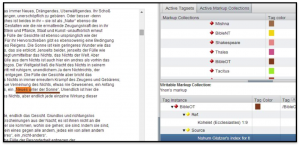 As a first step, we prepared an XML-TEI edition of the text on which a system of text re-use annotations can be appended as stand-off mark-up. Using CATMA –a Computer Aided Textual Markup & Analysis tool, we then inserted a first, proof-of-concept layer of text re-use annotations based on secondary literature, and u
As a first step, we prepared an XML-TEI edition of the text on which a system of text re-use annotations can be appended as stand-off mark-up. Using CATMA –a Computer Aided Textual Markup & Analysis tool, we then inserted a first, proof-of-concept layer of text re-use annotations based on secondary literature, and u
Based on this annotation pilot, we conceived the preliminary data model for tagging the text re-use in Rosenzweig’s writing. The next step will be to develop the online platform for the text that will, on highlighting a word or phrase, open a form where the user will be able to tag and comment on the intertextual text they and their fellows detect.
FUTURE PLANS: AUTOMATIC TEXT REUSE DETECTION
Given the density of quotations and allusions in the Star of Redemption, we hope to integrate text-mining tools developed in the framework of projects such as E-Traces: GERTRUDE or PhiloLogic. Such text-mining software would enable the automatic and manual comparison of a text against one of the largest digital corpus of German literature, the zeno.org-corpus, which is freely available under TextGrid.
For Rosenzweig’s non-German language sources, we will rely on traditional methods to face a more demanding challenge, that of detecting cross-lingual text re-use. Until larger non-German corpora are available, we intend to rely on the collaborative effort on the part of scholars and scholarship familiar with the Hebrew and Aramaic sources.
Alongside an online platform that collates intertextual references to their source text (right), we also envision incorporating translations of the Star in French, Italian, Dutch, English and Hebrew. Collated translations reveal further nuances of the Star as well as references that are more apparent in translation. Automatic text re-use detection provides mechanical enhancement of our collaborative efforts. It also enable us to compare and analyze the differences between the cognitive and computerized recognition of text re-use.
